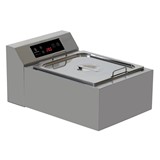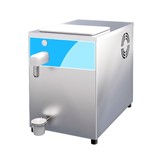Key Takeaways
- Match the finance to the asset's lifespan. Use short-term finance options for equipment you'll own and use for years (like ovens and coffee machines), and consider leasing for tech that becomes outdated quickly (like POS systems).
- A chattel mortgage is often the most popular option. It allows you to own the equipment from day one and claim the GST on the purchase price upfront in your next BAS, which is a significant cash flow benefit for many Australian businesses.
- Look beyond the interest rate. Always ask about the comparison rate, establishment fees, ongoing account fees, and any "balloon" or residual payment required at the end of the term to understand the true cost of the loan.
- Prepare your documents before you apply. Having your recent business activity statements (BAS), bank statements, and a clear idea of the asset you want to buy will significantly speed up the application process and show lenders you are organised.
- Leverage the instant asset write-off. Speak to your accountant about how the current instant asset write-off scheme can be used with finance products like a chattel mortgage to immediately deduct the full cost of eligible equipment, providing a major tax benefit.
Introduction: The strategic tool you can’t afford to ignore
For Australian hospitality businesses in 2025, the pressure has never been greater. You're navigating rising supply costs, persistent staff shortages, and razor-thin margins, all while trying to meet the high expectations of your customers. In this environment, having efficient, reliable equipment isn't just a nicety; it's a critical factor for survival and growth. But when cash flow is king, tying up thousands of dollars in an outright purchase isn't always the smartest move.
This is where equipment finance becomes one of the most powerful strategic tools at your disposal. According to the latest data from the Australian Bureau of Statistics, lending to businesses is on the rise, yet many small business owners are still hesitant or confused about their options. This article is a practical guide for Australian cafe, restaurant, and bar owners to demystify equipment finance. We'll break down your options, explain what lenders are looking for, and show you how to use finance to manage your cash flow, accelerate your growth, and build a more resilient business.
Why finance? The cash flow advantage
The most fundamental benefit of financing equipment is that it protects your working capital. The cash you have in the bank is your business's lifeblood—it covers wages, rent, and unexpected emergencies. Paying $20,000 upfront for a new coffee machine might feel responsible, but it can leave your business dangerously exposed if a slow trading period follows.
Financing allows you to acquire an income-producing asset immediately while spreading the cost over its useful life. The new, more efficient machine starts generating revenue from day one, and the regular, predictable finance payments are covered by the income it helps to produce. This smooths out your cash flow and allows you to invest your available capital in other growth areas, like marketing or hiring new staff.
Decoding your options: Chattel mortgage vs. lease vs. hire purchase
When you start looking for equipment finance in Australia, you'll encounter three main types. Understanding the difference is crucial as it impacts your ownership, cash flow, and tax position.
1. Chattel mortgage
This is often the most popular option for Australian businesses.
- How it works: The lender provides the funds to buy the equipment, and you take ownership of it immediately. The lender takes a "mortgage" (or security interest) over the equipment until the loan is fully paid off.
- Key advantages:
- You own the asset from day one.
- You can claim the full GST component of the purchase price on your next BAS.
- You can claim depreciation and the interest paid as tax deductions.
- It's often eligible for the government's instant asset write-off scheme.
2. Finance lease
A lease is essentially a long-term rental agreement.
- How it works: The finance company buys the equipment and rents it to you for a fixed period. At the end of the lease term, you typically have the option to buy the equipment for a "residual" value, upgrade to a new model, or simply return it.
- Key advantages:
- Lower monthly payments compared to a loan for the same asset.
- Great for equipment that dates quickly, like POS systems or computers, as you can easily upgrade.
- Lease payments are fully tax-deductible.
3. Hire purchase
This is a hybrid option that sits between a chattel mortgage and a lease.
- How it works: The finance company owns the equipment while you "hire" it from them through regular payments. You automatically gain full ownership once the final payment is made.
- Key advantages:
- Simple and straightforward structure.
- You can still claim depreciation and interest as tax deductions.
Preparing for your application: What lenders want to see
Getting approved for finance is much easier when you're prepared. Lenders are looking for confidence that your business is stable and can comfortably manage the repayments.
A realistic scenario: Applying for your first loan
You're a cafe owner who has been trading for 18 months and you want to finance a new $15,000 oven. The lender will likely ask for:
- Your ABN and business details: Proof that you are a legitimate, trading entity.
- Recent Business Activity Statements (BAS): Lenders will often look at your last 2-4 BAS statements to see your turnover and confirm your GST registration.
- Business Bank Statements: 3-6 months of statements to see your cash flow, average balance, and how you manage your finances.
- A quote for the equipment: Details of the exact asset you are purchasing.
Having these documents ready to go will make the process faster and smoother and present you as a professional, organised borrower. For established businesses seeking larger loans, you may also need to provide full financial statements like a profit and loss statement and balance sheet.
Beyond the interest rate: Avoiding the hidden traps
When comparing finance offers, it's easy to focus only on the interest rate. However, the true cost of a loan can be hidden in other fees and structures.
- Comparison rate: Always ask for the comparison rate, not just the headline interest rate. This rate includes most of the upfront and ongoing fees, giving you a more accurate picture of the total cost.
- Establishment and ongoing fees: Are there application fees? Monthly account-keeping fees? These can add up.
- Balloon payments: A "balloon" or residual payment is a lump sum you are required to pay at the end of the loan term. While it makes your regular monthly payments lower, you need to be prepared to pay out a large final amount (e.g., 20% of the original loan) to own the equipment outright.
A case study: The Daily Grind Cafe
Sarah, the owner of "The Daily Grind," a busy Melbourne cafe, needed to replace her ageing two-group coffee machine with a new three-group model costing $22,000 (including GST). She had the cash, but her accountant advised her to finance the purchase to preserve her working capital for an upcoming renovation.
Her options:
- A finance lease: This offered the lowest monthly payments, but she wouldn't own the machine, and the residual value at the end of the term was high. Since a coffee machine has a long, reliable lifespan, leasing didn't make sense.
- A chattel mortgage: This allowed her to own the machine immediately. The monthly payments were higher than the lease, but she could claim the $2,000 GST credit straight back on her next BAS.
The decision: Sarah chose the chattel mortgage. The immediate $2,000 GST refund was a huge cash flow boost. Furthermore, because she owned the asset, her accountant confirmed she could use the instant asset write-off to claim a tax deduction for the full business portion of the $20,000 purchase price in that financial year, significantly reducing her taxable income. The finance allowed her to get a critical, income-producing asset while keeping her cash reserves healthy and optimising her tax position.
Conclusion
Navigating the world of equipment finance can seem complex, but it doesn't have to be. By understanding your options, preparing your documents, and looking beyond the headline interest rate, you can turn financing from a simple loan into a powerful tool for business growth. In a competitive hospitality landscape, using finance wisely allows you to invest in the efficiency and quality your business needs to thrive while protecting your most valuable asset: your cash flow.





-160x160-state_article-rel-cat.png)


-160x160-state_article-rel-cat.png)









